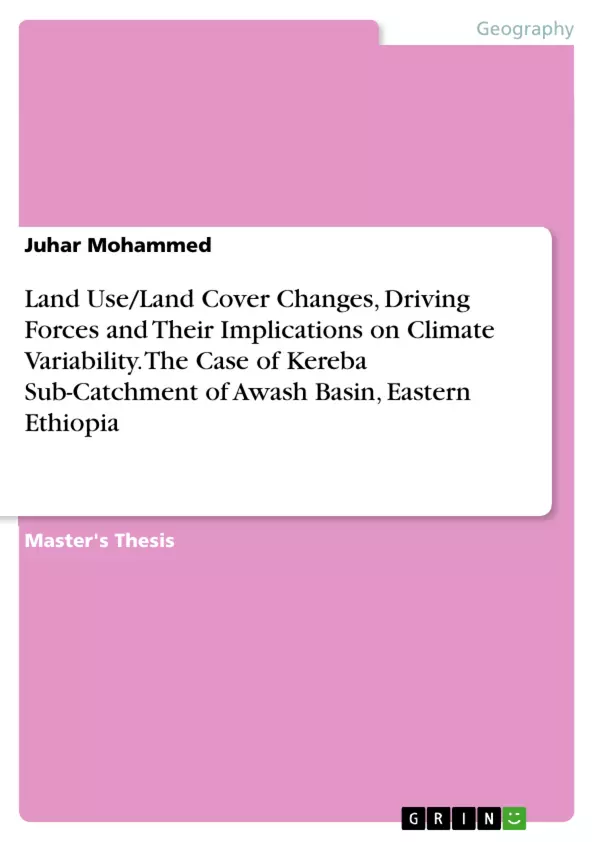Land-use/land-cover change is a major issue of global environmental change. This study was aimed to investigate LULCC, driving forces, and their implications on climate variability in the case of Kereba Sub-Catchment of Awash Basin, Eastern Ethiopia from 1999 to 2019.
Satellite image data were downloaded from the USGS websites. Gridded temperature and rainfall data were obtained from the NMSA of Ethiopia. Also, FGD, KII, and field observation were used to address drivers of LULCC. Google Earth and Global Positioning System were employed for ground verification. The maximum likelihood supervised classification method was used to classify LU/LC types, NDVI and LST using ERDAS imagine 2015 and ArcGIS 10.3 software.
Coefficient of Variation, Precipitation Concentration Index, and the moving average was used to analyze temperature and rainfall data. Regression analysis/Correlation coefficient was used to signify the association of LULCC and NDVI with climate variables. Landsat image of the study area was classified into agricultural land, forest land, grazing land, settlement, and shrub land.
Inhaltsverzeichnis (Table of Contents)
- Introduction
- Literature Review
- Land Use/Land Cover Change and Climate Variability
- Land Use/Land Cover Changes and Their Impacts on Climate
- Driving Forces of Land Use/Land Cover Changes
- Climate Variability and Impacts on Society
- Methodology
- Study Area
- Data and Methods
- Satellite Images
- Field Data Collection
- Data Analysis
- Results and Discussion
- Land Use/Land Cover Changes
- Spatial Distribution of Land Use/Land Cover Changes
- Dynamics of Land Use/Land Cover Changes
- Driving Forces of Land Use/Land Cover Changes
- Population Growth and Urbanization
- Agricultural Expansion
- Deforestation and Land Degradation
- Impacts of Land Use/Land Cover Changes on Climate Variability
- Conclusion and Recommendations
Zielsetzung und Themenschwerpunkte (Objectives and Key Themes)
This thesis investigates the complex relationship between land use/land cover changes and climate variability in the Kereba sub-catchment of the Awash Basin, Eastern Ethiopia. The study aims to analyze the spatial and temporal patterns of land use/land cover changes, identify the driving forces behind these changes, and assess their implications for climate variability.
- Land use/land cover changes and their impact on climate variability
- Driving forces behind land use/land cover changes
- The relationship between land use/land cover changes and climate change
- The implications of land use/land cover changes for the Kereba sub-catchment
- The importance of sustainable land management practices
Zusammenfassung der Kapitel (Chapter Summaries)
The Introduction chapter sets the context for the study, highlighting the importance of land use/land cover changes and their relationship with climate variability. It also outlines the research questions and objectives of the thesis. The Literature Review chapter explores existing research on land use/land cover changes, their driving forces, and their impacts on climate. It also reviews relevant studies related to the Awash Basin and Eastern Ethiopia.
The Methodology chapter details the study area, data sources, and research methods employed. The Results and Discussion chapter presents the findings of the research, analyzing the patterns of land use/land cover changes, identifying the driving forces, and examining their implications for climate variability.
Schlüsselwörter (Keywords)
The main keywords and focus topics of this thesis include land use/land cover changes, climate variability, driving forces, implications, Kereba sub-catchment, Awash Basin, Eastern Ethiopia, remote sensing, GIS, sustainable land management.
- Citation du texte
- Juhar Mohammed (Auteur), 2021, Land Use/Land Cover Changes, Driving Forces and Their Implications on Climate Variability. The Case of Kereba Sub-Catchment of Awash Basin, Eastern Ethiopia, Munich, GRIN Verlag, https://www.grin.com/document/1297654



